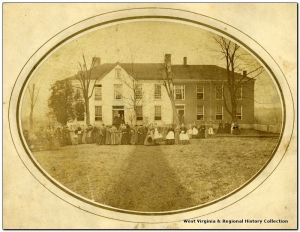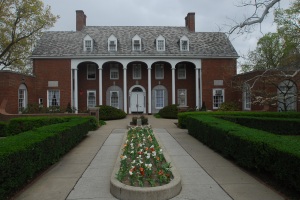By: Ashley Piomelli, Mackenzie Mays and Erica Mokay
Janitors at West Virginia University have seen a little girl in a yellow party dress dancing around the Mountainlair at night. Legend has it, she was buried years ago in a cemetery where Stewart Hall now stands.
An employee died after falling from the elevator shaft of the downtown library during maintenance. Students over the years have reported seeing him get on and off of the elevator late at night and vanish before they get to a chance to catch him.

Women pose outside the Woodburn Seminary in Morgantown in 1865. The seminary was built where Woodburn Hall stands now on the downtown WVU campus.
Even a ghostly cow moos in Woodburn, after a senior prank went wrong and lead the cow to its death in the clock tower.
Stories like these are what motivated Jason Burns, WVU professor and storyteller, to create the West Virginia Spectral Heritage Project.
The project was founded in 2006 and helps keep the history-rich ghost stories of the state alive. But, West Virginian ghostly tales are nothing new.
“West Virginia has such a rich culture of storytelling because it sits in the very center of the Appalachian region. Appalachian culture has been under attack since we moved into these mountains, and interest in it wanes as it gets more and more devalued by mainstream society. The stories I tell are not only to entertain, but to educate people about the value of Appalachian history and culture. All of us who are true Appalachian scholars revel in storytelling,” Burns said. “My main goal with the heritage project is to record as many of West Virginia’s ghost and monster stories as I can before they disappear entirely.”
Burns said it’s important to know that most ghost stories have a bigger purpose than to simply give listeners the creeps – they’re cautionary tales to teach life’s lessons.
One of his favorite stories comes from Middleway, W.Va. and tells the story of a stranger who asks for shelter because his health is fading. The man is dying and asks a non-catholic family to call a priest. The family denies the man his dying wish, and his ghost haunts him for eternity.

E. Moore Hall was built for Elizabeth Moore as an all girls facility. Moore died just one year prior to the building’s completion. Legend has it, her ghost still haunts the building, which now houses WVU offices for international students.
“Now the lesson in that story is – if someone is dying, then show some compassion and grant their dying wish,” Burns said. “You don’t have to believe in ghosts to enjoy a good ghost story. Within the stories, there is always some facet of history or culture that will still reach out and grab you, terrify you, and in the end let you go a better, and hopefully wiser, person. Ghost stories originally existed as tools for teaching – not as mere entertainment. Throughout West Virginia’s ghost stories, there are tales that teach us safety, honor, bravery, respect, love – all the basics of how to be a human being are in these tales.”
Burns said stoytellers like himself are helping mend the reputation the region has acquired over the years and stomp out negative stereotypes.
“Critics of storytelling – or of anything Appalachian – are usually misinformed about the culture. For the most part, they have a basic ignorance of Appalachia that is fed by many negative stereotypes in media and popular culture. However, in my personal experience that ignorance is beginning to be overshadowed by a re-evaluation of the value of the culture in music, literature and in the arts such as storytelling,” he said. “As a native West Virginian and Appalachian, I still find myself cringing whenever someone mentions the term ‘redneck’ without realizing the history behind the term but I am increasingly pleasantly surprised by the people who embrace the culture, seek it out and enjoy it. As time goes on, people are showing more interest in true Appalachian culture.”
But, sharing these ghostly tales isn’t just a hobby for Burns, who leads the Haunted WVU tour every Halloween and is a member of the West Virginia Storytellers Guild, — it’s a way of life.
“In my personal experience, I have improved immensely since I first began performing, and I hope to keep improving. Storytelling is a living, breathing art form that changes and evolves with each re-telling of a tale, and the same goes for storytellers,” he said. “For that small time performing, the story belongs to the storyteller and they fashion it in their image of what that story could be. Then, the listener gains that story and passes it on as they tell it to someone else. It’s an evolution of story that will continue until the story is no longer told.”

I would like to get in touch with Jason Burns.. I have wonderful haunted history stories at the Whipple company Store in Fayette co. WV. can he me at:304 465-0331
Hi Joy – you can email me anytime at mountainword@hotmail.com
Reblogged this on Living Ethnography and commented:
Just found this interesting page on haunted happenings at West Virginia University.